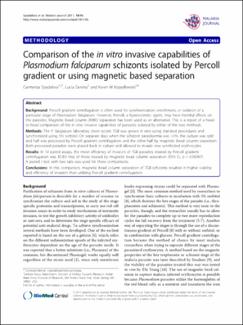| dc.contributor.author | Spadafora, Carmenza | |
| dc.contributor.author | Gerena, Lucia | |
| dc.contributor.author | Kopydlowski, Karen M. | |
| dc.date.accessioned | 2020-06-13T19:41:24Z | |
| dc.date.available | 2020-06-13T19:41:24Z | |
| dc.date.issued | 2011-04-18 | |
| dc.identifier.other | https://malariajournal.biomedcentral.com/articles/10.1186/1475-2875-10-96 | |
| dc.identifier.uri | http://repositorio-indicasat.org.pa/handle/123456789/59 | |
| dc.description | Background: Percoll gradient centrifugation is often used for synchronization, enrichment, or isolation of a particular stage of Plasmodium falciparum. However, Percoll, a hyperosmotic agent, may have harmful effects on the parasites. Magnetic bead column (MBC) separation has been used as an alternative. This is a report of a headto-head comparison of the in vitro invasive capabilities of parasites isolated by either of the two methods. Methods: The P. falciparum laboratory strain isolate 7G8 was grown in vitro using standard procedures and synchronized using 5% sorbitol. On separate days when the schizont parasitaemia was >1%, the culture was split and half was processed by Percoll gradient centrifugation and the other half by magnetic bead column separation. Both processed parasites were placed back in culture and allowed to invade new uninfected erythrocytes. Results: In 10 paired assays, the mean efficiency of invasion of 7G8 parasites treated by Percoll gradient centrifugation was 35.8% that of those treated by magnetic bead column separation (95% CI, p = 0.00067) A paired t test with two tails was used for these comparisons. Conclusions: In this comparison, magnetic bead column separation of 7G8 schizonts resulted in higher viability and efficiency of invasion than utilizing Percoll gradient centrifugation. | en_US |
| dc.description.abstract | Background: Percoll gradient centrifugation is often used for synchronization, enrichment, or isolation of a particular stage of Plasmodium falciparum. However, Percoll, a hyperosmotic agent, may have harmful effects on the parasites. Magnetic bead column (MBC) separation has been used as an alternative. This is a report of a headto-head comparison of the in vitro invasive capabilities of parasites isolated by either of the two methods. Methods: The P. falciparum laboratory strain isolate 7G8 was grown in vitro using standard procedures and synchronized using 5% sorbitol. On separate days when the schizont parasitaemia was >1%, the culture was split and half was processed by Percoll gradient centrifugation and the other half by magnetic bead column separation. Both processed parasites were placed back in culture and allowed to invade new uninfected erythrocytes. Results: In 10 paired assays, the mean efficiency of invasion of 7G8 parasites treated by Percoll gradient centrifugation was 35.8% that of those treated by magnetic bead column separation (95% CI, p = 0.00067) A paired t test with two tails was used for these comparisons. Conclusions: In this comparison, magnetic bead column separation of 7G8 schizonts resulted in higher viability and efficiency of invasion than utilizing Percoll gradient centrifugation. | en_US |
| dc.language.iso | eng | en_US |
| dc.rights | info:eu-repo/semantics/openAccess | |
| dc.rights | https://creativecommons.org/licenses/by-nc-sa/4.0/ | |
| dc.subject | Comparison of the in vitro | en_US |
| dc.subject | invasive capabilities | en_US |
| dc.subject | Plasmodium falciparum | en_US |
| dc.subject | schizonts isolated | en_US |
| dc.subject | Percoll gradient | en_US |
| dc.title | Comparison of the in vitro invasive capabilities of Plasmodium falciparum schizonts isolated by Percoll gradient or using magnetic based separation | en_US |
| dc.type | info:eu-repo/semantics/article | en_US |
| dc.type | info:eu-repo/semantics/publishedVersion | |

